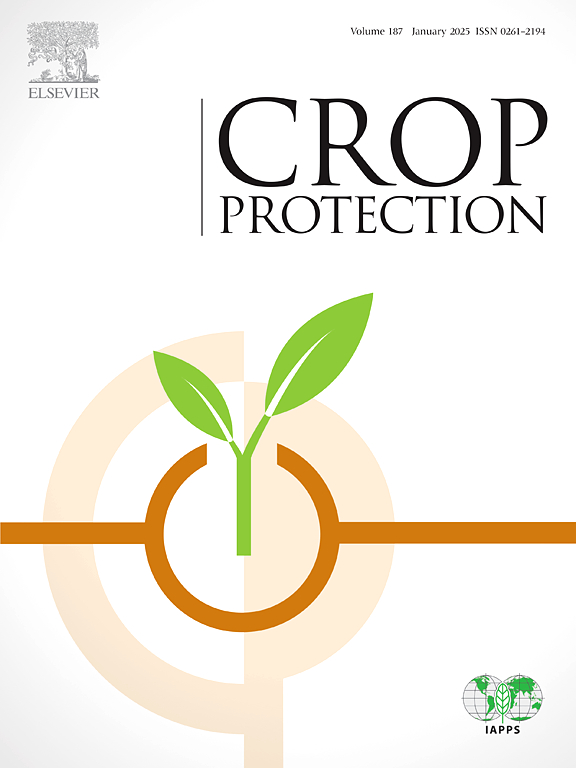Multi-component image analysis for citrus disease detection using convolutional neural networks
IF 2.5
2区 农林科学
Q1 AGRONOMY
引用次数: 0
Abstract
Citrus crops are susceptible to diseases such as Black Spot, Canker, and Greening, which significantly harm both the leaves and the fruits, ultimately reducing overall yield. Traditional visual inspection methods for identifying these diseases are labour-intensive and prone to inaccuracies. The present research proposes a deep learning approach utilizing Convolutional Neural Networks (CNNs) to overcome the limitations of manual inspection. Moreover, it introduces the utilization of combined visual features of citrus leaves and fruits for enhanced disease classification. The proposed multi-component approach demonstrates superior classification performance, achieving more accurate results than single-component-based classifications.
A dataset comprising 12,000 images, distributed across leaves, fruits, and their merged forms, was used for training, validation, and testing. Three CNN models were developed and evaluated: Leaf-Trained, Fruit-Trained, and Multiple Component-Trained CNNs. Performance was assessed using metrics such as accuracy, precision, recall, and F1-score, including their macro values, focusing on model generalization across different input types. The Multiple Component-Trained CNN outperformed the other models, achieving a validation accuracy of 97.75%, followed by the Leaf-Trained CNN at 95.50%. During testing, it also demonstrated superior performance across all input types, with accuracies of 94.75% on the leaf dataset, 92.87% on the fruit dataset, and 96.62% on the merged dataset. The results indicate that Black Spot is the most accurately classified disease, while Canker and Greening are less accurately classified. These findings highlight the potential of integrating various components of plants for enhanced disease classifications.
基于卷积神经网络的柑橘病害检测多分量图像分析
柑橘类作物易患黑斑病、溃疡病和绿化等病害,这些病害对叶片和果实都有严重危害,最终导致总产量下降。用于识别这些疾病的传统目视检查方法是劳动密集型的,而且容易出错。本研究提出了一种利用卷积神经网络(cnn)的深度学习方法来克服人工检测的局限性。此外,还介绍了利用柑橘叶片和果实的联合视觉特征来增强病害分类。所提出的多组分分类方法具有较好的分类性能,比基于单组分的分类结果更加准确。一个包含12,000张图像的数据集,分布在叶子、水果和它们的合并形式上,用于训练、验证和测试。开发并评估了三种CNN模型:Leaf-Trained, Fruit-Trained和Multiple Component-Trained CNN。使用准确度、精度、召回率和f1分数等指标评估性能,包括它们的宏观值,重点关注不同输入类型的模型泛化。Multiple Component-Trained CNN优于其他模型,验证准确率为97.75%,其次是Leaf-Trained CNN,验证准确率为95.50%。在测试过程中,它在所有输入类型上也表现出优异的性能,叶子数据集的准确率为94.75%,水果数据集的准确率为92.87%,合并数据集的准确率为96.62%。结果表明,黑斑病是最准确的分类疾病,而溃疡和绿化是不准确的分类。这些发现强调了整合植物的各种成分以增强疾病分类的潜力。
本文章由计算机程序翻译,如有差异,请以英文原文为准。
求助全文
约1分钟内获得全文
求助全文
来源期刊

Crop Protection
农林科学-农艺学
CiteScore
6.10
自引率
3.60%
发文量
200
审稿时长
29 days
期刊介绍:
The Editors of Crop Protection especially welcome papers describing an interdisciplinary approach showing how different control strategies can be integrated into practical pest management programs, covering high and low input agricultural systems worldwide. Crop Protection particularly emphasizes the practical aspects of control in the field and for protected crops, and includes work which may lead in the near future to more effective control. The journal does not duplicate the many existing excellent biological science journals, which deal mainly with the more fundamental aspects of plant pathology, applied zoology and weed science. Crop Protection covers all practical aspects of pest, disease and weed control, including the following topics:
-Abiotic damage-
Agronomic control methods-
Assessment of pest and disease damage-
Molecular methods for the detection and assessment of pests and diseases-
Biological control-
Biorational pesticides-
Control of animal pests of world crops-
Control of diseases of crop plants caused by microorganisms-
Control of weeds and integrated management-
Economic considerations-
Effects of plant growth regulators-
Environmental benefits of reduced pesticide use-
Environmental effects of pesticides-
Epidemiology of pests and diseases in relation to control-
GM Crops, and genetic engineering applications-
Importance and control of postharvest crop losses-
Integrated control-
Interrelationships and compatibility among different control strategies-
Invasive species as they relate to implications for crop protection-
Pesticide application methods-
Pest management-
Phytobiomes for pest and disease control-
Resistance management-
Sampling and monitoring schemes for diseases, nematodes, pests and weeds.
 求助内容:
求助内容: 应助结果提醒方式:
应助结果提醒方式:


